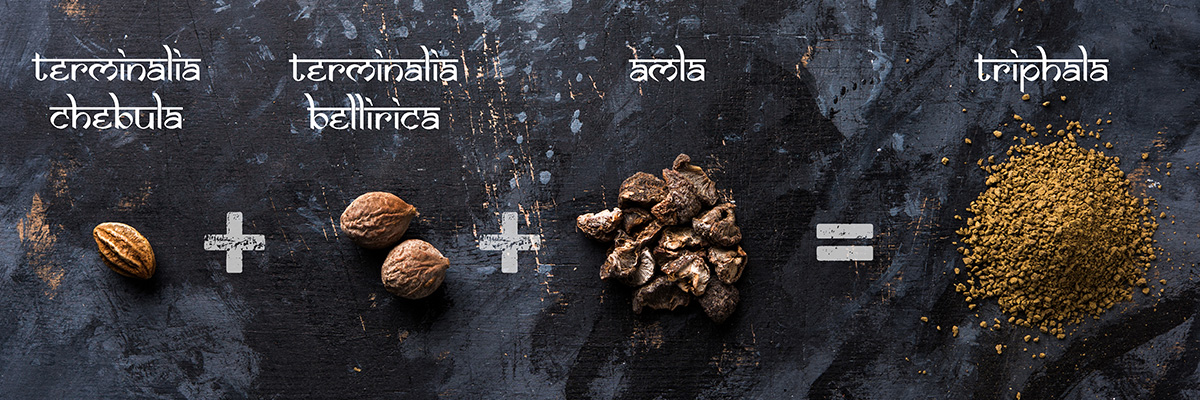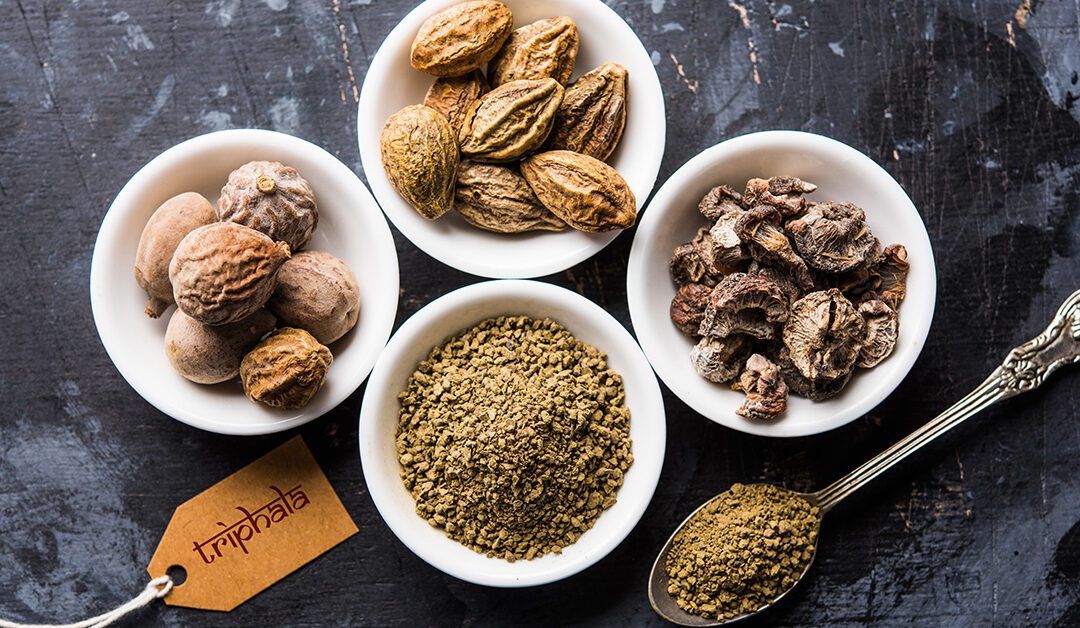Introduction
One of the most ancient polyherbal medicines ever discovered for the treatment of human multi-alignment is Triphala. It is formulated with the blending of three vital dry fruits, each in an equal proportion (1:1:1) of Amla (Emblica officinalis), Haritaki (Terminalia chebula), and Bibhitaki (Terminalia bellerica). More than a thousand years ago, Triphala Rasayana was created. It is written by the great doctor Charaka, who advocated for lifelong health in his book Charaka Sanhita. Additionally, the Sushruta Sanhita describes the benefits of Triphala as a remedy for wounds and ulcers. As a result, it is one of the oldest herbal remedies that has been used continuously.
What are the ingredients of Triphala?
The dry fruits of three herbs are combined in equal proportions to form a super-ayurvedic drug known as Triphala churn, which may also be available commercially as capsules, tablets, or digestive chyawanprash. The following are the three dry fruits:

Amla (Emblica officinalis or Phyllanthus emblica Linn), which is also called Indian gooseberry, has high amounts of polyphenols, which act as antioxidants and antibacterial agents, as well as Vitamin C, fiber, and chromium, which help control blood sugar levels in patients suffering from type II diabetes. It has been shown to improve immunity, age control, anti-cancer, skin restoration, hair growth, dental health, and relief from gastritis, ulcers, and heartburn.
Haritaki (Terminalia chebula) is one of the renowned Ayurvedic medicines known as the “king of medicines.” The description of Terminalia chebulais not only an Ayurvedic hallmark medicine, but Tibetan medicine is also well mentioned in their manuscript. It has potent efficacy in treating colds, lung disease, infertility, asthma, indigestion, diarrhea, and gastritis, and Haritaki powder is also a natural laxative. During recent pharmacological research, haritaki was discovered to be anticarcinogenic, antidiabetic, antibacterial, and antioxidant. The chemical profiling of Haritaki found several types of glycosides, including chebulosides I and II, chebulin, and 2,4-chebulyl-β-D-glucopyranose. It is the active ingredient in Triphala powder.
Bibhitaki (Terminalia bellerica);Terminalia bellirica is known for its astringent nature and is locally called baheda, bahera, behada, bastard myrobalan, or beleric. Bibhitaki is also one of the important hallmarks of ayurvedic medicine, used for various alignment as laxative action, enhancing immunity, stress relief, liver purification acting as a hepatoprotective, and healing ulcers and wounds. It is also helping to promote the digestive system. The green fruit Terminalia bellirica is used to treat coughs, and its pulp is used to treat dysentery, diarrhea, piles, and menstrual disorders.
Terminalia bellirica is a rich source of bioactive components such as beta-sitosterol, ethyl gallate, chebulagic acid, gallic acid, ellagic acid, and galloyl glucose, which have potent medicinal efficacy. Other novel bioactive compounds are also available, such as saponins in the form of bellericoside and bellericanin, alkaloids, and tannins such as chebulinic acid and chebulagic acid.
As a result, the three important medicinal dry fruits with the homogenized mixture develop a synergetic effect on Triphala, which is many folds enhanced efficacy power in Triphala powder.
What are the benefits of Triphala powder?

- Triphala is an ayurvedic staple that has been used for thousands of years, and its popularity is growing due to its numerous benefits, which include improving immunity, being anti-inflammatory, improving blood circulation, being cardiotonic, lowering blood sugar and cholesterol, lowering the risk of obesity with daily consumption, and being free of side effects when compared to synthetic medicine.
- People are consuming more Triphala to boost immunity during the COVID-19 epidemic scenario. It is also used for purging toxic substances from the body. Triphala powder is one of the holistic approaches in the medication system that is developing an equilibrium energy balance within the three doshas of VATA, PITTA, and KAPHA.
- Triphala powder not only cures the disease, but it also promotes prevention and increases the body’s resistance capacity to sustain a normal life. It is considered a potent natural antioxidant to protect cells, tissues, and organ systems of the body, which play a vital role in minimizing the aging process, activating the rejuvenation of body cells, and promoting overall well-being.
- In recent studies of Triphala, one of its most effective uses was as an antineoplastic agent, i.e., anticancer, antimutagenic, and cytotoxic activity.
What is the market’s most popular brand of Triphala?
There are several world-class brand-name Triphala products available in powder, capsule, or liquid forms on the market, but they should be authentic and laboratory-tested.
How much Triphala should you take?
The optimal doses of Triphala medicine are determined by the doctor’s prescription, health practitioners’ recommendations, the use for disease cure, and the patient’s physical condition. In general, a half to full teaspoon of Triphala powder mixed with mild hot water or honey can be used for constipation, while one to two teaspoons per day can be used for immunity boosting, liver, and stomach problems. Some health practitioners even recommend taking Triphala tea or Triphala paste on a daily basis to boost a healthy lifestyle. However, before consuming Triphala, you should take proper advice from an authentic Ayurvedic doctor or another health practitioner.
How do you confirm the quality of Triphala
Triphala’s quality or standard is one of the major concerns of regulatory bodies due to adulteration. However, Ayurvedic Pharmacopoeia of India (API) methods such as organoleptic, pharmaceutical, physicochemical, phytochemical, and heavy metals evaluation can confirm it. At present, Cultivator Phyto Lab, one of the AYUSH-approved laboratories, has developed several methods for HPLC, LC-MSMS, GC-MSMS ICP-MS, FTIR, and biological analysis to maintain the quality control of your brand products as per regulatory bodies.
Author : Dr.Sanjoy Gupta and Sandeep Sharma
References :-
- https://www.ncbi.nlm.nih.gov/pmc/articles/PMC5567597/pdf/acm.2017.0083.pdf. DOI: 10.1089/acm.2017.0083
- https://www.sciencedirect.com/science/article/pii/B9780128138205000222
- https://www.sciencedirect.com/science/article/abs/pii/S0378874121000556?via%3Dihub
- https://www.ncbi.nlm.nih.gov/pmc/articles/PMC3902605/pdf/AYU-34-331.pdf

